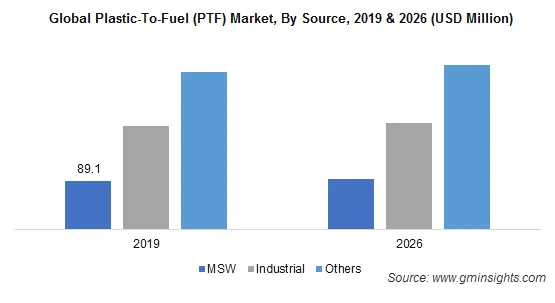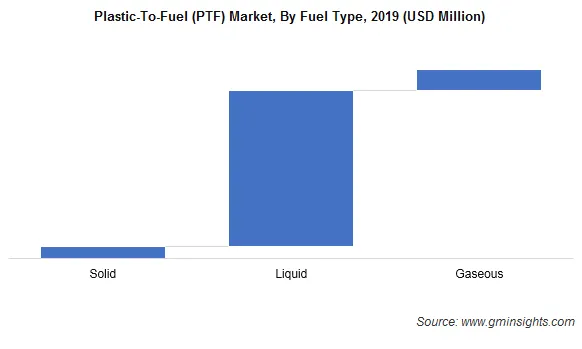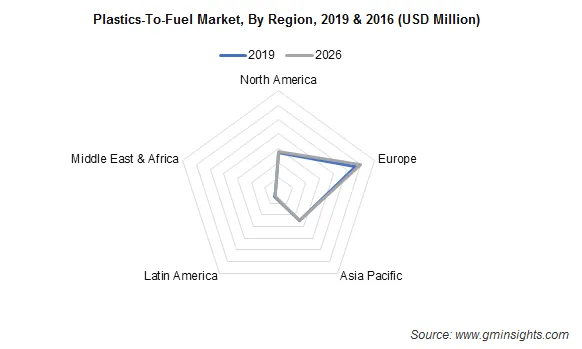Get a free sample of Plastics-To-Fuel (PTF) Market
Thank you!
Your inquiry has been received. Our team will reach out to you with the required details via email. To ensure that you don't miss their response, kindly remember to check your spam folder as well!
Form submitted successfully!
Error submitting form. Please try again.
Get a free sample of Plastics-To-Fuel (PTF) Market
Thank you!
Your inquiry has been received. Our team will reach out to you with the required details via email. To ensure that you don't miss their response, kindly remember to check your spam folder as well!
Form submitted successfully!
Error submitting form. Please try again.
Plastics-To-Fuel Market Size
Plastics-To-Fuel Market size was valued at USD 572.7 million in 2019 and is estimated to exhibit over 2.5% CAGR from 2020 to 2026. Depleting availability of fuel sources along with flourishing cleantech industry and Emerging regulations for GHG emissions from petrochemical industries & refineries will create growth potential for PTF demand.
The Plastics-To-Fuel (PTF) market is a part of the circular economy model, that thrives to produce high-quality plastic products from wastes. The technology is highly capital-intensive and Return-On-Investment (ROI) period for the market generally varies from two to five years. However, the industry is witnessing an increasing number of manufacturers in the U.S. and Europe owing to well-established infrastructure for waste management.

Presence of stringent government regulatory norms in regions including Europe is supporting the adoption of plastic to fuel technology. Major countries including Germany, France, Italy, and Denmark have reported a substantially high degree of recycling & energy recovery rate along the plastic waste disposal value chain. In 2016, Germany reported the energy recovery rate of post-consumer plastic waste and plastics packaging waste at 60.6% and 58% respectively.
| Report Attribute | Details |
|---|---|
| Base Year: | 2019 |
| Plastic To Fuel Market Size in 2019: | 572.7 Million (USD) |
| Forecast Period: | 2020 to 2026 |
| Forecast Period 2023 - 2032 CAGR: | 2.6 |
| 2023 Value Projection: | 594.1 Million (USD) |
| Historical Data for: | 2016 to 2019 |
| No of Pages: | 185 |
| Tables, Charts & Figures: | 211 |
| Segments Covered: | Source, Depolymerization, Fuel Type, and Region |
| Growth Drivers: |
|
| Pitfalls Challenges: |
|
The growth factors responsible for such a high recovery rate are subjected to the EU waste legislation, that mandates countries to recycle plastic wastes, a minimum of 55% by 2025. Such trends have opened new avenues for plastic to fuel manufacturers over the last few years. These plastics to fuel market manufacturers can expand their cooperation with plastic converters and recyclers to increase the waste recovery rate in Europe, further contributing to industry development. The market for plastic waste pyrolysis oil to witness 5.3% growth during the forecast period.
Plastics-To-Fuel Market Analysis
The plastics to fuel technologies are opportunistic and reflect positive outlook to plastic manufacturers. However, the current scenario of treating waste into fuel is not as profitable as that of conventional fuel making. The key challenge present in the market is economies of scale. Most manufacturers have observed that the feedstock quality largely affects the fuel quality.
Additionally, the waste collected from municipal areas are highly contaminated with food, organic, or other types of chemicals, that escalates the manufacturing costs. Also, the commercial viability of plastics-to-fuel is largely dependent on end-user requirements, selection of depolymerization technology, and type & quality of feedstocks. Such trends are likely to hamper the plastics-to-fuel market growth.
The ongoing coronavirus pandemic will adversely impact potential demand for the plastics-to-fuel market. In 2020, conventional fuel consumption dropped by 7% - 8% as compared to 2019, that is attributed to the shutdown or partial closure of major petrochemical plants & refineries. However, on the supply side, feedstock manufacturers may expect a high demand owing to the rising need for sanitary products globally.

In 2019, the Municipal Solid Waste (MSW) segment contributed to over USD 85 Million in the overall plastics-to-fuel market share. MSW segment will lead the industry size in Latin America and the Middle East & Africa owing to high amount of wastes generated from the household & municipal sectors. The availability of feedstock material and cost of obtaining plastic wastes will have a substantial impact on the consumption trends of municipal solid plastic wastes to fuel industry.
The thermal pyrolysis will witness over 2.5% CAGR from 2020 to 2026. Growing demand for liquid fuel in the end-user industry along with the cost-effectiveness of pyrolysis than other thermal degradation technology will enhance plastics-to-fuel market segment penetration. The process involves the thermal decomposition of plastics in the absence of oxygen. The process enables the reuse of the energy and raw materials of the waste that reduces the environmental impact of the incorrect disposal of waste.

Liquid fuel will account for over 80% share in plastic-to-fuel market by 2026. Pyrolysis converts around one ton of plastic waste to more than 100 gallons of fuel. However, the quantity of fuel generated depends upon a variety of things including contamination of feedstock, process selection, etc. Many oil producers are focusing on utilizing plastics-to-fuel due to growing concerns towards high-quality & sustainability among plastic producers, further increasing the popularity of liquid fuel in the industry.

The Europe plastics-to-fuel market is likely to account for over 45% share in the overall industry size. The share is attributed to presence of multiple plastic to fuel conversion facilities that offer high recycling and energy recovery rate from plastic wastes. The region also aims to reduce its GHG emissions by 40% from 1990 levels, promoting the growth of renewable & cleantech sectors.
Plastics-To-Fuel Market Share
The marketplace is highly fragmented with presence of multiple industry participants in the current scenario generating small revenue. Intense capital requirements, fuel specifications, and unavailability of government subsidies are some of the key restraining factors faced by product manufacturers. Technological advancements are likely to have a huge impact on the industry development.
Some of the key manufacturers of the plastics-to fuel industry are:
- Vadxx
- Nexus Fuel
- Klean Industries
- POLCYL
- Plastic2Oil, Inc.
- CbS Technologies
- Neste
Some of the key strategies adopted by these manufacturers are production capacity expansion, collaboration with plastic recyclers & converters, and new product development.
The Plastics-To-Fuel Market report includes in-depth coverage of the industry with estimates & forecast in terms of volume in million gallons and revenue in USD million from 2016 to 2026 for the following segments
By Source
- Municipal Solid Waste (MSW)
- Industrial
- Others
By Depolymerization
- Thermal Degradation
- Pyrolysis
- Gasification
- Hydrogenation
- Catalytic Degradation
By Fuel Type
- Solid
- Liquid
- Gaseous
The above information is provided on a regional and country basis for the following:
By Region
- North America
- U.S.
- Canada
- Europe
- Germany
- UK
- France
- Spain
- Italy
- Russia
- Asia Pacific
- China
- India
- Japan
- South Korea
- Indonesia
- Malaysia
- Latin America
- Brazil
- Mexico
- Middle East & Africa